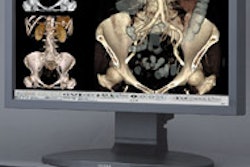CHICAGO - A new mobile flat-panel x-ray system, a 64-slice PET/CT scanner for cardiac imaging, and new multislice CT scanners are among the highlights in the booth of Siemens Medical Solutions at this year's RSNA meeting. The Malvern, PA, company is also showcasing new developments in 3-tesla MRI, a full-field digital mammography system that has FDA clearance, and PACS/RIS integration.
MRI
In MRI, the company is discussing the migration of its Tim (total imaging matrix) whole-body surface coil concept to its 3-tesla Magnetom Trio platform, according to Nancy Gillen, vice president of the Malvern, PA, company's MR division. Tim involves the use of multiple surface coils that can all be plugged into the patient table at once, saving time for imaging facilities by enabling the use of imaging protocols that switch easily from targeting a small region of interest to whole-body studies -- without requiring patients to be pulled from the magnet.
Siemens originally launched Tim at last year's RSNA meeting for the Magnetom Avanto scanner, and in addition to being migrated to the Trio scanner it is also being developed for the company's older Magnetom Symphony unit. At this year's RSNA, the company is discussing how Tim Trio creates the possibility of new clinical applications in abdominal, cardiac, spine, whole-body, and neurological imaging -- such as MR spectroscopy with a head coil. Siemens is also showing how Tim can be combined with the vendor's iPAT parallel imaging technique for a speed increase that's 16 times that of the system without iPAT, Gillen said. Tim will be available on the Trio and Symphony scanners in September 2005.
The company is also using the show to highlight Magnetom Espree, an ultra-short-bore 1.5 tesla scanner introduced earlier in the year. Espree sports a magnet bore that 70 cm wide and 125 cm long, reducing the potential for claustrophobia among patients. Two Espree systems have been installed since the scanner's launch, and Siemens highlighted clinical images collected with the units -- such as a carotid angiography imaging conducted with a 16.7-second acquisition, according to Gillen.
X-ray
Siemens is showing off a flat-panel digital detector option for its Mobilett XP mobile x-ray system. Mobilett XP Digital features a 43 x 35-cm (17 x 14-inch) flat-panel detector for enhanced viewing, and can store up to 3,000 images in its internal image memory, according to the vendor.
The system also includes a touchscreen with an intuitive user interface, Siemens said.
Image data can be transmitted through wireless access or a cable to the hospital's information system for archiving and documentation.
Siemens is also highlighting Arcadis Orbic 3D, a mobile C-arm with intraoperative 3D imaging capabilities that can generate 3D images directly in the operating room. It features an isocentric design and 190° orbital movement that enables 3D imaging, according to the firm.
Arcadis Orbic 3D is suited for intraoperative 3D imaging of bones and joints of the upper and lower extremities; cervical, thoracic, and lumbar spine; pelvis and hip; and maxillofacial areas, Siemens said.
Siemens is also discussing DynaCT, a technique that allows its Axiom Artis FD systems to perform angiographic CT studies. Image acquisition can be completed with a 10-second C-arm spin; the volume set is then reconstructed on Siemens' Leonardo workstation, Siemens said.
DynaCT yields soft tissue images that enable differentiation in the range of 10 Hounsfield units, which offers the ability to visualize soft-tissue abnormalities such as abdominal tumors and cerebral hemorrhaging, according to the firm. It's available for use with Siemens' Axiom Artis dFA, dTA, and dBA systems.
In addition, Siemens is exhibiting a mobile flat-panel detector for its Axiom Sireskop SD fluoroscopy system. With the addition of a flat-panel detector, Sireskop SD can now handle all digital radiography and fluoroscopic procedures, according to the vendor.
A DiamondView software upgrade for its Axiom Aristos line is also being shown. DiamondView is a contrast-enhancing software tool, offering benefits such as optimizing the dynamic range from the bone to the skin line, said Regina Radtke, director of product marketing, radiography systems.
The upgrade includes OrthoSpine and OrthoLeg, two orthopedic software packages. OrthoSpine and OrthoLeg allow orthopedic surgeons to generate, measure, diagnose, and document full leg and spine skeleton images, said Gerhard Schmiedel, head of radiography solutions. Images are captured using an automated sequential acquisition mode, and are composed on Siemens' Leonardo workstation.
CT
At last year's RSNA meeting, Siemens launched Somatom Sensation 64, the company's flagship 64-slice CT scanner. This year, the company moved its focus to other price segments in the multislice CT segment. Somatom Spirit is a new entry-level dual-slice CT scanner, while Somatom Sensation 40 creates a new price point in the multislice Sensation product line.
Somatom Spirit has a 2 mega-heat-unit (MHU) x-ray tube, a gantry aperture of 70 cm, and a rotation speed of 0.8 seconds, and also has a streamlined user interface designed to make it easier to operate. Siemens sees the system fitting into emerging markets where users are looking to get into multislice scanning for the first time, as well as the private-practice market in the U.S., according to Bernd Montag, president of the company's CT division.
Sensation 40 creates a new price point in the Sensation product line. The scanner uses the same Straton x-ray tube, which toggles its electron beam to create two alternating and overlapping x-ray projections with each gantry rotation. This enables the system to double the amount of image data collected without increasing dose. Sensation 40 has a gantry rotation speed of 0.37 seconds, and the scanner will be available in the summer of 2005.
For the Sensation 64, some 100 units have been installed since the scanner's debut at last year's RSNA show. The company is highlighting a number of advanced visualization applications, such as computer-aided detection (CAD) applications for both lung screening (called Lung Care) and virtual colonoscopy (called syngo Colonoscopy). The company is working on software for cardiac exams, according to Montag.
Finally, Sensation Open is a new scanner introduced earlier in 2004 with an 82-cm field-of-view for specialized applications like radiation therapy planning, bariatric patients, and interventional CT. Siemens is displaying the system with a work-in-progress 600-lb patient table.
Molecular imaging
Multimodality vendors with PET/CT scanners have been steadily boosting the slice counts in these hybrid systems as multislice technology progresses, and this year is no exception. Siemens' PET/CT platform, biograph, has been upgraded with 64-slice technology to create biograph 64.
biograph 64 is targeted at cardiac applications that would benefit from the combination of anatomical and functional imaging provided by CT and PET. The system uses a CT scanner with a 0.33-second rotation speed and lutetium oxyorthosilicate (LSO) crystals, according to Markus Lusser, vice president of worldwide sales and marketing for the company's nuclear medicine group. The product will begin shipping in the second half of 2005.
On the workstation side, Siemens demonstrated two new applications for its Leonardo computer, first demonstrated at the Society of Nuclear Medicine show in June. FusedVision3D enables users to visualize PET scans fused with images from multiple anatomical modalities, such as CT and MRI. The application automatically fuses images from multiple modalities -- even if they were acquired with non-Siemens equipment -- by using anatomical landmarks to find co-registration points. FusedVision3D is also interactive, enabling users to navigate through volumes while reconstruction occurs on-the-fly.
The second Leonardo application, TrueD, enables historical comparison of two datasets, for comparing old and new CT exams in PET/CT studies.
Finally, Symbia is a SPECT/CT system first introduced at the SNM show in June, and Siemens demonstrated the system to an RSNA audience for the first time. The company has installed the first Symbia unit, at the University of Michigan Health System in Ann Arbor, and will install two more by the end of 2004. Symbia comes in two-slice, six-slice, and attenuation-correction versions, Lusser said.
Women's imaging
After a long wait, Siemens is now able to show its Novation DR full-field digital mammography (FFDM) unit as a commercial product after receiving FDA approval for the system in August. In addition to the system, Siemens is demonstrating advances in the workstation technology used with the unit, which uses an amorphous selenium detector with a 24 x 29-cm imaging area.
Siemens has migrated Novation DR's acquisition workstation (AWS) to the syngo platform, and has added an additional computer display, called Mammo Report Plus, that supports new features. The new syngo-based workstation was shown as a work-in-progress, and is expected to be available in January or February, according to Joanne Scott-Santos, women's health product manager.
Also shown as a work-in-progress was the integration of Novation DR FFDM images with digital spot mammography images from the vendor's Opdima system. Availability of this feature is expected in the spring of 2005.
Another new work-in-progress application for the AWS computer is tomosynthesis, an advanced mammography application that uses a tilting x-ray tube head to collect breast images at different angles that can then be fused into 3D volumes. Siemens has collected the first tomosynthesis patient images with a Novation DR unit installed at Duke University in Durham, NC, Scott-Santos said.
The company is also developing a computer-aided detection capability to analyze tomosynthesis images, and is also discussing its support for CAD images from R2 Technology of Sunnyvale, CA, and iCAD of Nashua, NH.
PACS/RIS
Siemens is emphasizing the integration of PACS, RIS, and postprocessing technologies, allowing users to access all information at a single workplace, said Rik Primo, national director, marketing, and strategic relationships.
Cosmos, which was shown at last year's RSNA meeting as a work-in-progress, includes the firm's syngo user interface and integration with its Soarian Clinical Access software, facilitating an electronic medical record, Primo said. Siemens' Leonardo advanced visualization capabilities have been incorporated as part of the PACS workstation software in its Cosmos integrated radiology suite
Siemens has also added orthopedic templating software and floating software licenses. Siemens is also displaying different Cosmos configurations, including integration with IWM (Siemens' European RIS), as well as with SOPMS (Siemens Outpatient Management System). SOPMS is the vendor's RIS for the outpatient market.
In RIS developments, Siemens is pointing to enhancements for Novius RIS. As part of V27, Siemens has incorporated tools to facilitate paperless workflow, including document management for scanning, managing, and distributing of documents. Also new: user-defined, online "interactive documents" for the elimination of paper forms, as well as embedded support for capture of electronic signatures.
The company has also added predefined clinical alerts to automatically notify users when clinical conditions have been met, as well as flexible worklists and teaching folders. The addition of an application programming interface (API) allows users to access data from various clinical and nonclinical sources, Siemens said.
Ultrasound
Siemens is shining the spotlight on its Encompass Release for Sequoia scanner, emphasizing the scanner's new patient-specific imaging capabilities.
Native TEQ dynamic ultrasound technology optimizes system performance by automatically responding to patient-specific information and automatically correcting unbalanced, undergained, and overgained images, said Bill Carrano, vice president of worldwide marketing for Siemens' ultrasound division. Native TEQ allows users to freely scan any anatomic area without ever touching a gain control, Carrano said.
In other patient-specific imaging enhancements, Encompass includes background noise suppression, automatically detecting and suppressing noise. As a result, signal-to-noise ratio is optimized throughout the entire field-of-view, Carrano said. Encompass will begin shipping in early 2005.
In Antares developments, Siemens' Clarify vascular enhancement technology is now available on all Antares transducers. Siemens is also showing off its InMotion software upgrade for its G60S and G50 scanners, featuring its fourSight 4D imaging technique.
By Brian Casey and Erik L. Ridley
AuntMinnie.com staff writers
November 29, 2004
Copyright © 2004 AuntMinnie.com



















